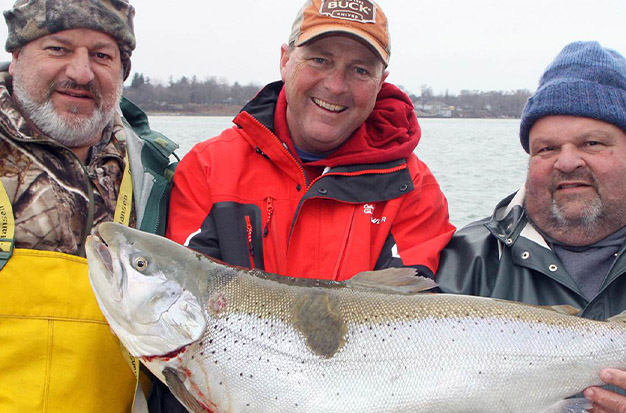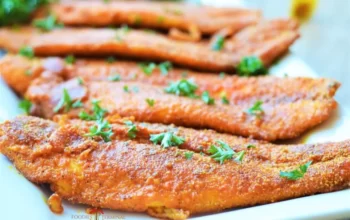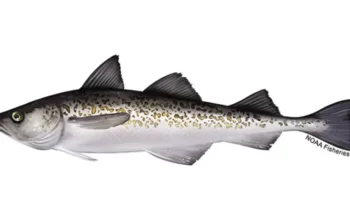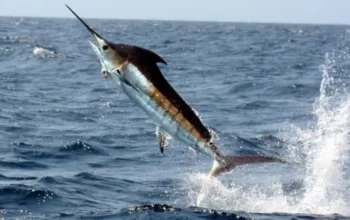How can you catch lake trout? In North America, anglers prefer lake trout more than any other fish. These dark green freshwater fish with pale yellow spots enjoy the cold, deep lake water. Although their natural population has been greatly reduced by overfishing, they are frequently stocked in lakes from the midwestern US to Canada.
Table of Contents
Lake Trout Range
The northernmost parts of North America are typically where native lake trout can be found most easily. Native lake trout can be found in numerous lakes in Canada, Alaska, the Great Lakes, and a few other smaller bodies of water in the Northeast.
To be sure, these fish have been brought to North America as non-native species as well. Lake trout fishing has become popular in Yellowstone National Park in recent years, especially in Yellowstone Lake, where they have since developed into a problematic species.
The Yellowstone cutthroat trout, a keystone species that is native to the area, is threatened by invasive lake trout, so if you do manage to hook one while fishing in Yellowstone, you should be aware that it is prohibited to release it. So catch them, keep them, eat them, and have fun with them.
Lake Trout Habitat
A high level of oxygenation is essential for the survival of the cold-water Lake trout species. The only significant native game fish that live in deep and cold water fisheries are the trout species, which are also popular game fish. Lake trout live in oligotrophic lakes, such as those in the Great Lakes region and northern Canada. In these cold-water lakes, Lake trout can frequently be found suspended deep in the basin.
In comparison to other species, lake trout have a relatively small range. Natural habitats for lake trout exist in Canada and the northern regions of North America, including the Great Lakes. Additionally, some of Alaska and the Northeastern United States are home to them.
Seasonality
The availability of lake trout fishing throughout the year is one of its most alluring features. Anglers will need to modify their approach as the seasons change, but with a little practice, it’s not that difficult.
Lake trout are most active in the spring and fall at lower elevations. The fish are moving around during these months due to the cold water. Since the newly opened water will be sufficiently cold after the ice melts, lake trout will typically move closer to the surface.
Lake trout are rarely found anywhere other than the deeps in the middle of summer, when lakes are at their warmest, making this the most difficult time of year to fish for them.
Lake Trout Bait & Tackle
There are many tried-and-true methods for successfully pursuing lake trout. The majority of lake trout needs can be met with a light-weight spinning rod and 6-pound monofilament line in most locations.
Minnows are typically the preferred choice for anglers who prefer live bait because they have been successful when pursuing lake trout. It should come as no surprise that the minnow on the end of your line may appear to be a worthy meal since lake trout typically feed on small to medium-sized baitfish in their natural habitat. However, nightcrawlers and worms can also make good choices for live bait, just like other fish.
There are many options available if lure fishing is your preferred method. Giant lake trout can be caught using spinners, jigs with long tails, and jerk baits. Other respectable choices include flies, spoons, and inline spinnerbaits. Finally, PowerBait or Power Eggs can be effective, but only for fish that have been introduced or stocked.
Lake Trout Fishing Equipment
Lake trout prefer cooler water, so depending on the temperature, they can be found swimming at different depths throughout the year. Even for those just learning how to fish, a depth finder can be helpful when pursuing lake trout. You can increase your chances of fishing success by using this technology to quickly and precisely determine where the fish are. Even mark your location so you’ll know where to go back!
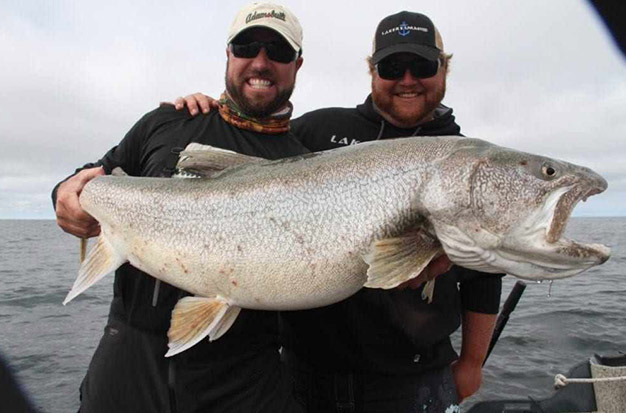
Time To Fish For Lake Trout
The best time of day to catch lake trout is one of the more crucial things to comprehend if you want to have a successful day on the water. The weather plays a big role in choosing the best time. The likelihood of catching a lake trout increases whenever it is overcast because lake trout prefer to avoid bright lights. or decide to go fishing between dawn and 11:00 a.m. or at twilight. Not only will the lake trout feel more at ease venturing out at these hours, but they also bite most during feeding time when bugs are active.
How To Catch Lake Trout?
The methods for catching lake trout are as varied as the bait, but novice fishermen should start with one of the choices listed below.
When using live bait, secure your worm or minnow to your hook by attaching a weight to the line just above. By doing this, you can escort your bait underwater.
Cast into an area you have determined to be ideal lake trout habitat while adding a bobber a few feet above your hook. Set your hook and reel in your fish as soon as your bobber jerks or dives under the water. This technique should be used in the early and late seasons when lake trout are more likely to hang out in shallower waters.
Fishing off the lakebed rather than the surface will be necessary around the middle of summer. To accomplish this, set up your rig as previously mentioned, but without the bobber. This will enable you to target deeper fish during the warmer months by letting your bait float just above the lakebed while the lead weight sinks to the bottom of the lake.
Finally, if you’re fishing with any of the aforementioned lures, aim for lake trout habitat and cast there. You should wait a short while for your spinner, spoon, jig, or jerk bait to sink before starting to retrieve it back to the boat. Because anglers must experiment with retrieval speed and depth to pinpoint the location of lake trout, this technique calls for a little more expertise.
10 Best Tips To Catch Lake Trout
Don’t Skimp On The Leader
Many people imagine finesse-style fishing with light leaders for tiny fish in clear water when they think of trout fishing. However, a light leader is probably going to result in disappointment given the massive toothy, hard, and hooked (if male) jaws of these lake trout, which can weigh anywhere between 2-4kg. I’ve been starting with 8 lb j-thread as a baseline and might increase to 12 lb (but not lower). Furthermore, fish readily consume 8–10 cm lures, so lure sizes are frequently larger than what would be expected. The Daiwa double clutches in sizes 75 and 95 and the Duo Realis minnow in 80mm are two effective models.
The Early Bird Catches The Trout
In the first or last half hour of light, many excellent trout, especially browns, are caught. This doesn’t mean getting up early or even launching at first light; rather, it means launching in the dark and getting set up to fish as soon as (or as late as) the last rays of light touch the water. This does require some commitment during the dead of winter, as well as good wet weather gear, but the rewards are worth it, and you can be sure that you have at least given yourself the best chance of success.
Just Keep Casting
Winter lake fishing is similar to bream flats fishing. High frequency plus long casting distance equals more water covered and a greater chance of covering a fish, according to a straightforward mathematical formula. Because of this, it is crucial to have confidence in the equipment you are using (rather than wasting time constantly switching lures) and to have a high-quality setup that casts effectively and without issues. I’ve been fishing with a TD Sol 2500D paired with a Rebellion 682 MLFS and 8lb J-braid grand this lake season, and I’ve found it to be fantastic and trouble-free, knocking over many large browns on it.
Use Spoons
Slower drag speeds make spoons an appealing lure for lake trout, who strike viciously at them due to their steady, slow wobbling motion. In terms of depth targeting, spoons also give you a lot of flexibility because they let you slip the lure with only slight variations in speed into the target area.
Watch Your Rod
Lake trout typically swim away unnoticed after grabbing your bait. If you see your rod bend into a bow, you can be sure that something has tangled your line. Avoid this if the trout tries to swim under your boat. You have two options: either quickly lower your rod tip directly into the water to force the fish back onto your side of the boat, or bring it around the bow of your boat to finish the fight from a different angle. A fish will always be lost if the line gets tangled on the boat’s bottom.
Bounce The Bottom
By literally bouncing the bottom of the water, you can create deeper ripples that draw Lake Trout from much farther away by using good 20–30 pound test line and a sturdy 30–pound fluorocarbon leader. Your job is to handle them up from the depths, make the grab, and have a professional photographer take your picture.
Be Vigilant
It pays to keep an eye out rather than just casting blindly when fishing a large lake, even though it may not be as exciting as pursuing trout in a river run. A productive area can be identified by remaining vigilant and keeping an eye out for baitfish concentrations, (surface or sounder) groups of feeding water birds, flowing water or winlanes, as well as the obvious, moving trout.
Fish The Cooler Waters
Since lake trout prefer cooler water climates, they tend to move deeper into the water column as the surface temperature rises. The best conditions for trout fishing on Kasba are usually cloudy with little wind because the lake’s consistently cold waters throughout the summer mean you won’t have to search too far or too deep.
Use Depth Finders
It would be much simpler to plan your entire fishing trip if you could map the lake trout’s swim patterns. You shouldn’t think of using depth finders as “cheating,” but rather as becoming “well-informed” of your surroundings. Below 30 feet off of shoals and reef structure, many trout schools congregate.
Know Your Equipment
When searching for trophy Lake Trout, medium-heavy 7′ rods with at least 20 pound of test line should do the trick. However, if you’re looking for some fast-paced action, a lighter option like a light-medium action rod with 6 to 10 pound test line can make for an exciting afternoon. You should be able to get assistance choosing the necessary tackle at your neighborhood fishing store.
Conclusion
If you live nearby and want to stock your freezer with fish, lake trout fishing is a great place to start.
The cooler waters these fish reside in make them a fantastic three-season option, despite the fact that summer fishing can be challenging. Wishing you luck on the water and a delicious meal!

